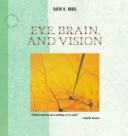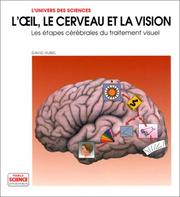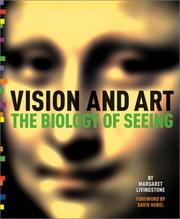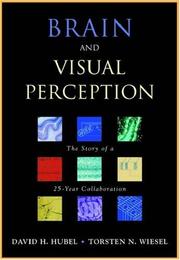| Listing 1 - 7 of 7 |
Sort by
|

ISBN: 0716750201 9780716750208 Year: 1988 Volume: 22 Publisher: New York (N.Y.) : Scientific American books,
Abstract | Keywords | Export | Availability | Bookmark
 Loading...
Loading...Choose an application
- Reference Manager
- EndNote
- RefWorks (Direct export to RefWorks)
Vision --- Visual cortex --- 611.84 --- Area striata --- Striate area --- Striate cortex --- Occipital lobes --- Eyesight --- Seeing --- Sight --- Senses and sensation --- Blindfolds --- Eye --- Physiological optics --- Eyes. Organs of sight, vision --- Vision. --- Visual cortex. --- Visual Cortex --- physiology. --- 611.84 Eyes. Organs of sight, vision
Book
ISBN: 9070157926 Year: 1990 Publisher: Maastricht : Natuur en Techniek,
Abstract | Keywords | Export | Availability | Bookmark
 Loading...
Loading...Choose an application
- Reference Manager
- EndNote
- RefWorks (Direct export to RefWorks)
Gezichtsvermogen --- 612.843.3. --- zien --- ogen --- 591.185.6 --- $?$93/11 --- 612.84 --- Ogen --- Ogen. --- Visuele perceptie. --- neurobiologie --- Physiology of nerves and sense organs --- 612.82

ISBN: 0716760096 Year: 1995 Publisher: New York Scientific American Library
Abstract | Keywords | Export | Availability | Bookmark
 Loading...
Loading...Choose an application
- Reference Manager
- EndNote
- RefWorks (Direct export to RefWorks)

ISBN: 2902918674 9782902918676 Year: 1994 Publisher: Paris: Pour la science,
Abstract | Keywords | Export | Availability | Bookmark
 Loading...
Loading...Choose an application
- Reference Manager
- EndNote
- RefWorks (Direct export to RefWorks)
Comment l'oeil transforme-t-il les signaux électriques en une image cohérente et identifiable, riche en informations sur la forme, la couleur, la profondeur et le mouvement. Comment l'information visuelle est-elle réorganisée et analysée, étape après étape, par le cerveau ? Ce livre répond à cette question grâce à ses remarquables schémas d'organisation des cellules cérébrales en feuillets, colonnes, îlots et modules, selon leur fonction dans le traitement visuel. L'œil est à l'avant-poste du cerveau : lorsque nous regardons une scène, la lumière bombarde, dans notre rétine, plus de 100 millions de cellules photo réceptrices; celles-ci convertissent l'énergie lumineuse en signaux électriques qui sont envoyés vers les aires visuelles de notre cerveau. Comment ce dernier transforme-t-il ces signaux en une image cohérente et identifiable, riche en informations sur la forme, la couleur, la profondeur et le mouvement ? L'image du petit bonhomme qui se contenterait, dans notre cerveau, d'observer l'image de la scène directement transmise par l'œil est bien sûr fausse, comme l'est probablement aussi la théorie des «cellules de la grand-mère», spécifiquement chargées de reconnaître le visage d'une grand-mère... Ces préjugés ont été balayés par les études très précises (à l'échelle de la cellule) de la physiologie du cerveau. Ce livre dévoile comment l'information visuelle est réorganisée et analyse, étape après étape; il révèle les remarquables schémas d'organisation des cellules cérébrales en feuillets, colonnes, îlots et modules, selon leur fonction dans le traitement visuel.
Vision --- Anatomie --- Couleur --- Perception --- Vision, Ocular.

ISBN: 0810904063 9780810995543 Year: 2002 Publisher: New York (N.Y.) : Abrams,
Abstract | Keywords | Export | Availability | Bookmark
 Loading...
Loading...Choose an application
- Reference Manager
- EndNote
- RefWorks (Direct export to RefWorks)
Visual perception. --- Color vision. --- Painting --- Perception visuelle --- Vision des couleurs --- Peinture --- Psychological aspects --- Aspect psychologique --- Psychology. --- Visual perception --- Color vision --- -By Margaret Livingstone ; Foreword by David Hubel --- kunst --- schilderkunst --- waarneming --- perceptie --- kleur --- 7.017 --- 7.017.4 --- 72.017.4 --- 75 --- Oil painting --- Painting, Primitive --- Paintings --- Graphic arts --- Chromatic vision --- Color discrimination --- Color perception --- Color-sense --- Optics, Psychological --- Vision --- Perception --- Visual discrimination --- Psychology --- Esthetica: kleur; kleurharmonie --- Optische werkingen in de architectuur: kleur; textuur --- Schilderkunst --- 75 Schilderkunst --- 72.017.4 Optische werkingen in de architectuur: kleur; textuur --- 7.017.4 Esthetica: kleur; kleurharmonie --- Philosophy of science --- By Margaret Livingstone ; Foreword by David Hubel
Book
ISBN: 0716711508 0716711516 9780716711513 Year: 1979 Publisher: San Francisco (Calif.): Freeman,
Abstract | Keywords | Export | Availability | Bookmark
 Loading...
Loading...Choose an application
- Reference Manager
- EndNote
- RefWorks (Direct export to RefWorks)
Physiology of nerves and sense organs --- Brain. --- Brain --- Physiology --- Collected works. --- Cerebrum --- Mind --- Central nervous system --- Head

ISBN: 0195176189 9780195176186 Year: 2005 Publisher: New york: Oxford university press,
Abstract | Keywords | Export | Availability | Bookmark
 Loading...
Loading...Choose an application
- Reference Manager
- EndNote
- RefWorks (Direct export to RefWorks)
Outside back cover : "Scientists' understanding of two central problems in neuroscience, psychology, and philosophy has been greatly influenced by the work of David Hubel and Torsten Wiesel : What is it to see? This relates to the machinery that underlies visual perception, How do we acquire the brain's mechanisms for vision? This is the nature-nurture question as to whether the nerve connections responsible for vision are innate or whether they develop through experience in the early life of an animal or human. This is a book about the collaboration between Hubel and Wiesel, which began in 1958, lasted until about 1982, and led to a Nobel Prize in 1981. It opens with short autobiographies of both men, describes the state of the field when they started, and tells about the beginnings of their collaboration. It emphasizes the importance of various mentors in their lives, especially Stephen W. Kuffler, who opened up the field by studying the cat retina in 1950, and founded the department of neurobiology at Harvard Medical School, where most of their work was done. The main part of the book consists of Hubel and Wiesel's most important publications. Each reprinted paper is preceded by a foreword that tells how they went about the research, what the difficulties and the pleasures were, and whether they felt a paper was important and why. Each is also followed by an afterword describing how the paper was received and what developments have occurred since its publication. The reader learns things that are often absent from typical scientific publications, including whether the work was difficult, fun, personally rewarding, exhilarating, or just plain tedious. The book ends with a summing-up of the authors' view of the present state of the field. This is much more than a collection of reprinted papers. Above all it tells the story of an unusual scientific collaboration that was hugely enjoyable and served to transform an entire branch of neurobiology. It will appeal to neuroscientists, vision scientists, biologists, psychologists, physicists, historians of science, and to their students and trainees, at all levels from high school on, as well as anyone else who is interested in the scientific process."
Physiology of nerves and sense organs --- Visual pathways. --- Visual perception. --- Voies optiques --- Perception visuelle --- #KVHB:Perceptie --- #KVHB:Visuele waarneming --- Visual pathways --- Visual perception --- Optics, Psychological --- Vision --- Perception --- Visual discrimination --- Visual system --- Afferent pathways --- Psychological aspects --- Visual Perception - physiology - United States --- Biomedical Research - history - United States --- History of Medicine, 20th Cent. - United States --- Visual Perception --- Biomedical Research --- History of Medicine, 20th Cent.
| Listing 1 - 7 of 7 |
Sort by
|

 Search
Search Feedback
Feedback About UniCat
About UniCat  Help
Help News
News